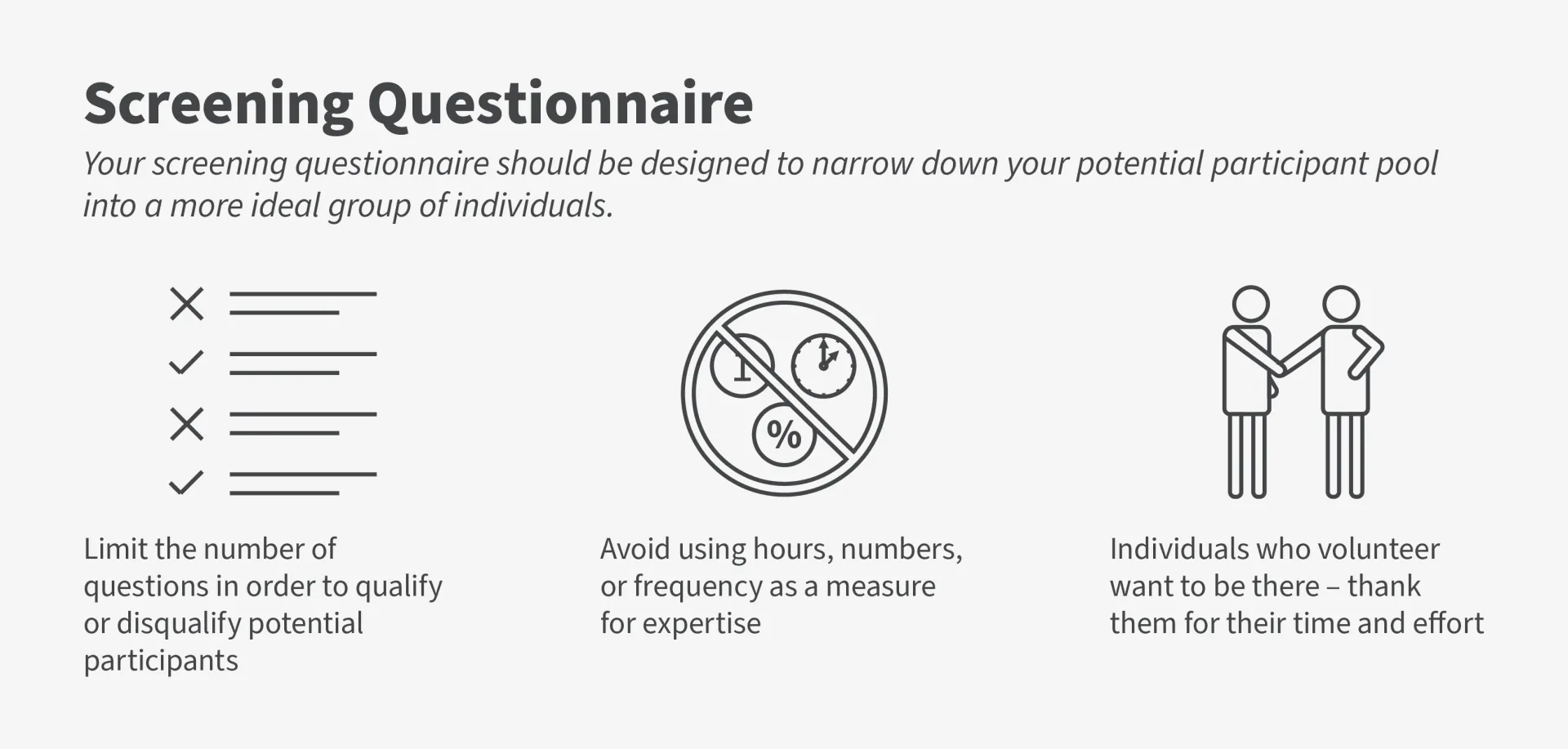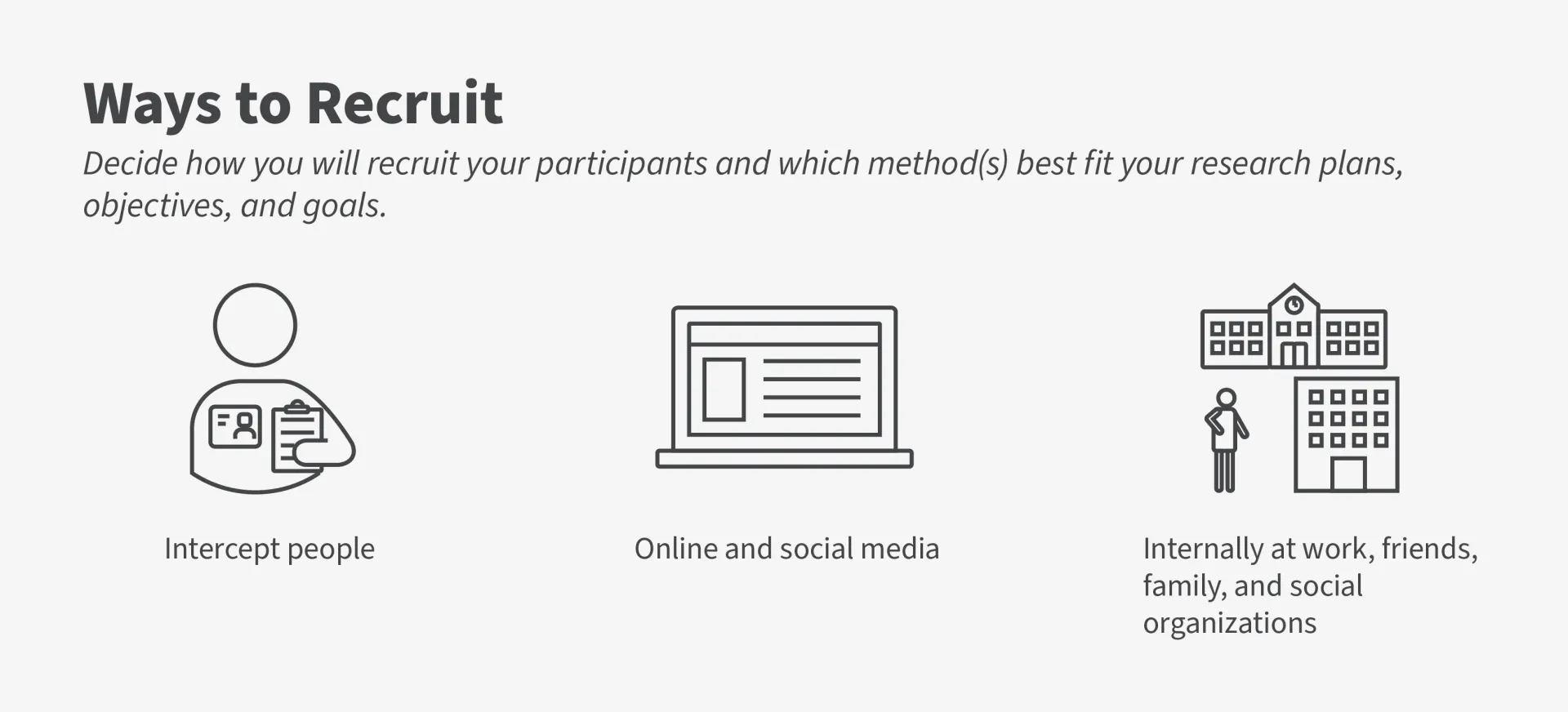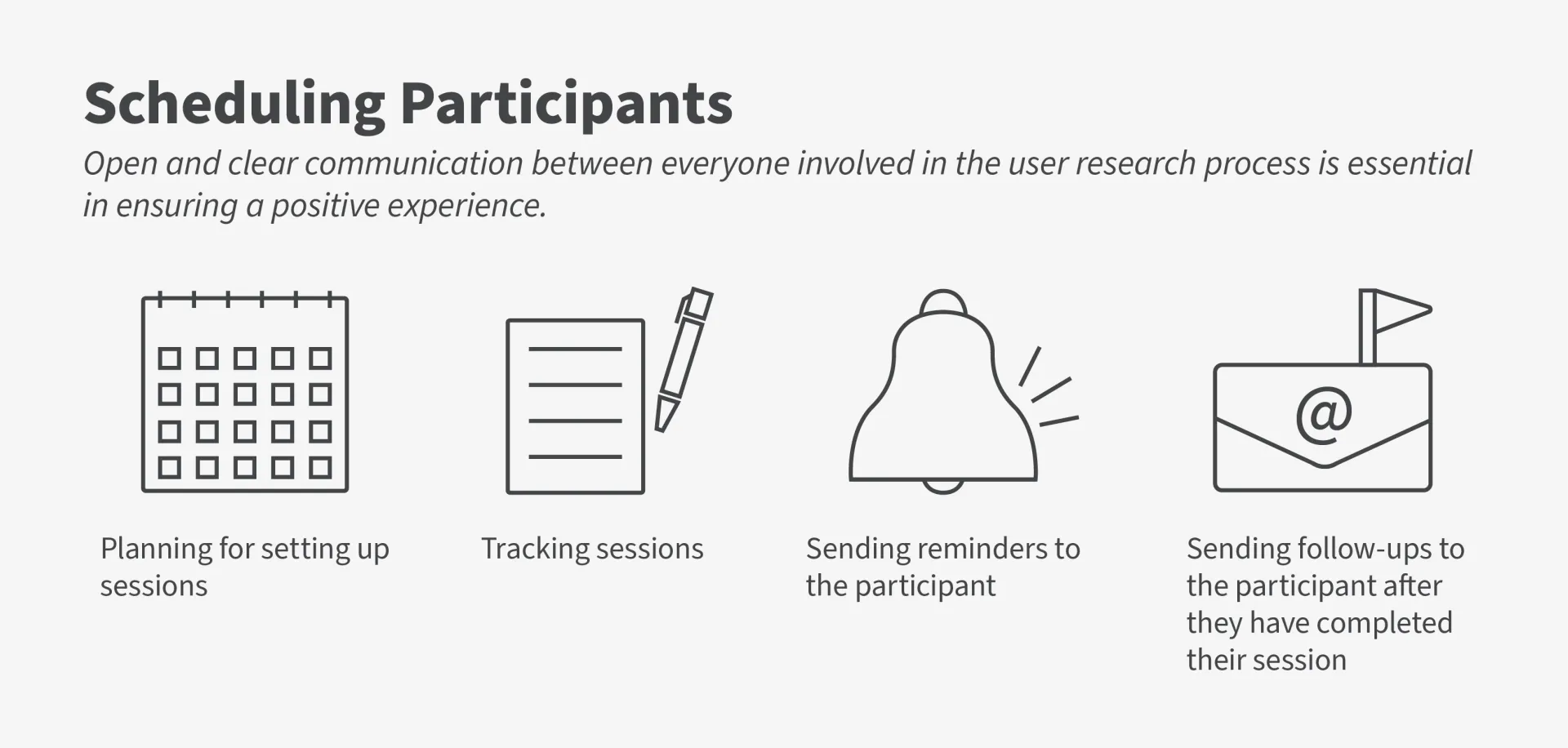Basics of User Research Lesson | 15 Minutes
Lesson Objectives
- Understand how to set yourself up for successful recruitment
- Understand how to screen your participants
- Understand the different ways to recruit participants
- Understand the process for scheduling participants
User research is about understanding the needs, goals, and behaviors of your customers. Therefore, recruiting the ‘right’ participants for your study is essential to gathering significant feedback that can lead to the most effective changes to your organization's services and products.
Before you can conduct user research, you need to find, screen, and recruit your participants. At minimum, the people you find should reflect a portion of your audience, with a diverse, representative group of users being the most ideal. Once you screen those potential participants, the individuals you select should be able to help you reach your research objectives and goals.
Setting Yourself Up for Success
As you prepare for the recruiting phase in the user research process, you want to review your research plan to ensure your recruitment criteria will help you reach your research objectives and goals.
When thinking about your recruitment criteria, focus on finding people who do the behavior you are looking to test. How a person interacts with and reacts to your organization's services can help inform the quality and performance of your current service delivery.
Before recruiting participants, consider the following:
- Your participants are your customers
- Focus on your participants’ behavior as a fit for your study
- Don’t focus on demographics unless it is specific to your study
- Don’t treat participants as data points
- Don’t use a participant's response as interchangeable information
- Think about what it may take when people show up to your research session
- Every interaction is an opportunity to learn from your participants – be open and listen with purpose
Screening Your Recruits
At this point in the user research process, you can probably visualize your perfect participant and the answers they would provide to you. This mental image is a good starting point for creating your screening questionnaire.
Your screening questionnaire should be designed to narrow down your potential participant pool into a more ideal group of individuals that can help you gain the most impactful insights from your research.
When creating your screening questionnaire, consider the following:
- Know how you plan on using the collected data from the questions you ask
- Use open-ended questions to get the participant to explain their answer instead of just stating a response
- Limit the number of questions in order to qualify or disqualify potential participants
- Keep the questionnaire short and easy to understand – avoid jargon and use plain language
- Avoid using hours, numbers, or frequency as a measure for expertise
- Embrace the uniqueness of individuals and respect their perspectives – don't be too quick to disqualify someone
- Build and foster a relationship with the potential participant – the more comfortable a participant, the more authentic their responses will be
- Individuals who volunteer to be a potential participant want to be there – thank them for their time and effort
Remember, you want to avoid any bias in selecting participants. Your goal is to learn more about your users and recruit participants that will provide answers that are open and honest.
Ways to Recruit
Now that you have a screening questionnaire ready to help you narrow down your pool of potential participants, you must decide how you will recruit your participants and which method(s) best fits your research plans, objectives, and goals.
Intercept People
Going to where your participants are is a great way to recruit your participants based on behavior. Being in the ‘right’ place means you can recruit users onsite where they are accessing your organization’s services.
Here are some helpful tips for conducting intercepts:
What you should look like
- Approachable and having a purpose
- Clothes are important (be comfortable – think business casual)
- Props (clipboards for example) are important
- ID badges to help identify who you are and what you may be doing
Introducing yourself to strangers
-
Who you are, what you are doing, and what you would like to ask of them
Before you even get started to intercept strangers, be sure to
- Know what your goals are with your study and why
- Be ready with quick, friendly, and appropriate questions
- Use your own style – don't read someone else’s script
- Be culturally aware of how to approach and talk to people
- Be inquisitive rather than confrontational
- Work the research angle – people like to help
Success rate and time spent
- It can be hard to find participants, especially, if you are looking for a particular group
- Give yourself plenty of time to complete your task, set goals for the day, and expect that not everyone wants to help
Picking a location
- Depending on what you are looking for, do your research on where the population may be
- Pick a place with plenty of foot traffic, but where people have enough time to talk to you (ex: community center)
Safety
- Pair up and work in daylight
- Know your surroundings
- Make sure your cell phone is charged and people know where you are
- Have an emergency plan
Eye Contact
- If people are ignoring you, check yourself and your approach – you may need to reset
Online and Social Media
The reach of the internet and social media cannot be underestimated. Recruiting participants using online groups, forums, and your social media following is a great resource for conducting low-cost recruiting.
Depending on your online presence, you may have a limited reach and your potential participant pool may be too similar in views and behaviors. Be sure to screen all potential participants thoroughly to ensure your research will yield insightful outcomes.
Internally at Work, Friends, Family, and Social Organizations
Using your existing network of individuals can be helpful and easier when trying to recruit participants. As long as your potential recruits can remain professional, pass the screening questionnaire, and are reliable, this is a category of participants you should not overlook.
Note: You aren't limited to using just one method to recruit participants. Be open to trying different methods to obtain the most ideal user group for your study.
Scheduling Your Participants
When scheduling your participants in-person or virtually, make sure you have a plan in place for setting up sessions, tracking sessions, sending reminders to the participant, and sending follow-ups to the participant after they have completed their session. Having open and clear communication between everyone involved in the user research process is essential in ensuring a positive experience.
Keep in mind, we are all human. Although we plan, schedule, and keep constant communication, things come up, circumstances change, and flexibility is necessary. When scheduling participants, be ready to adapt. They are helping you by participating and being willing to share their perspective; be sure to work within their schedule as best you can.
In Summary
Recruiting participants to be a part of your user research effort goes beyond their contributions to your study. When we interact with our customers, we are creating additional touchpoints between them and our organization.
When recruiting participants, you are building and fostering customer relationships. Treat everyone with respect, thank them for their time, and remember, your preparation can make all the difference in creating significant research outcomes and a positive customer experience.
Resources
Article:
Tips for capturing the best data from user interviews (18F)
Design & research in critical times (18F)
Best Practices for Remote User Experience Research (Digital.gov)
Find Participants for User Experience Studies (Digital.gov)
Web Resource:
US Web Design: Design Principles (USWDS)
18F User Experience Design Guide: Research (18F)
Download:
Increasing Public Participation in User Research (GSA)
Video:
Five Ways to Recruit Participants for User Research (NN Group)



